Nokia's Failure in Retail Industry: Analysis and Recommendations
VerifiedAdded on 2023/06/10
|10
|2589
|487
AI Summary
This report analyses the reasons behind Nokia's failure in the retail industry and provides recommendations for improvement. It includes a discussion on current market trends and competition, areas of failure, and models of analysis such as SWOT and PESTLE.
Contribute Materials
Your contribution can guide someone’s learning journey. Share your
documents today.

Module: (FY028) Inquiry Based Learning
Topic:(Title:Research Title)
Student’s Name:
Student ID:
Lecturer’s Name:
Due Date:
Topic:(Title:Research Title)
Student’s Name:
Student ID:
Lecturer’s Name:
Due Date:
Secure Best Marks with AI Grader
Need help grading? Try our AI Grader for instant feedback on your assignments.

2
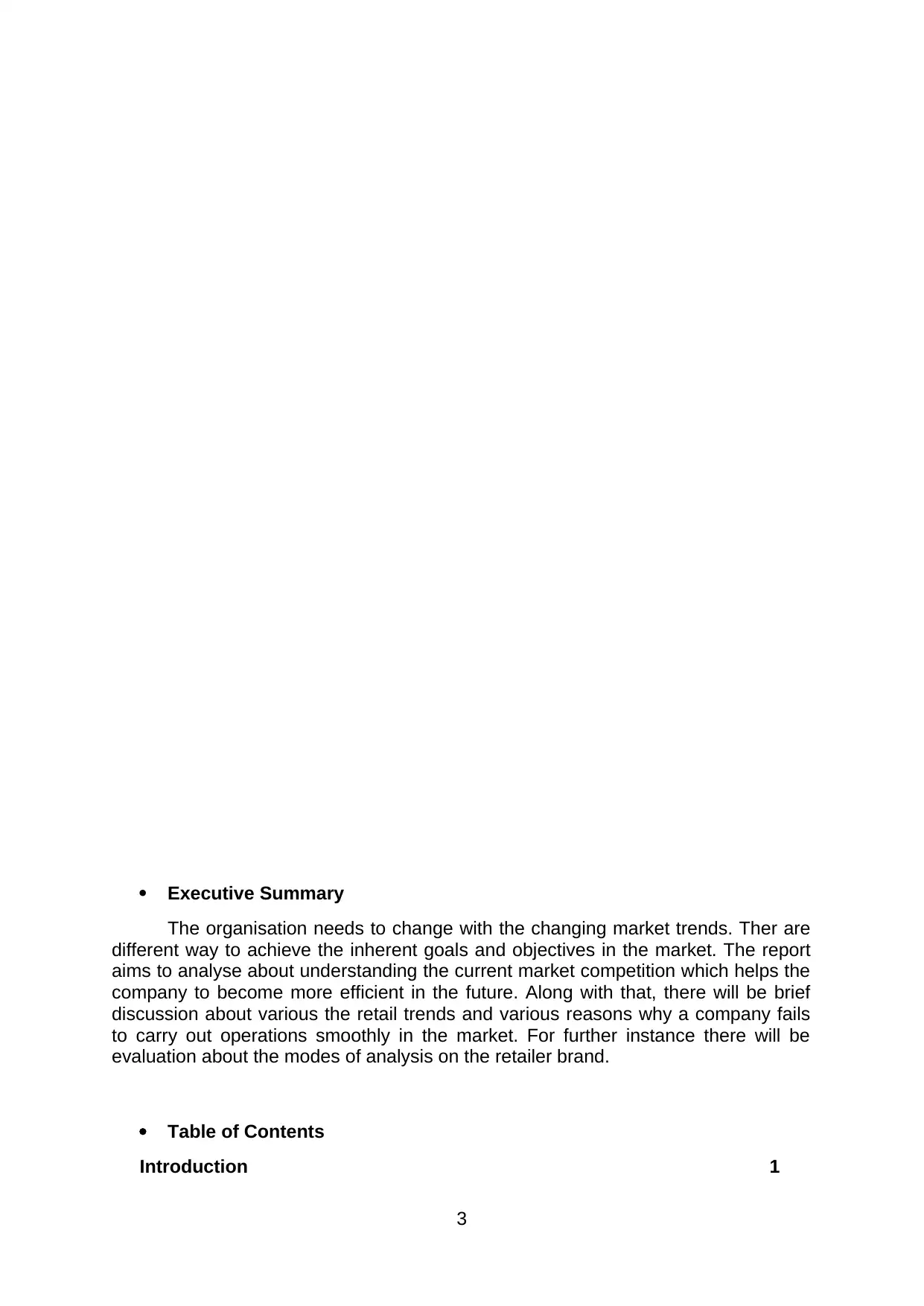
Executive Summary
The organisation needs to change with the changing market trends. Ther are
different way to achieve the inherent goals and objectives in the market. The report
aims to analyse about understanding the current market competition which helps the
company to become more efficient in the future. Along with that, there will be brief
discussion about various the retail trends and various reasons why a company fails
to carry out operations smoothly in the market. For further instance there will be
evaluation about the modes of analysis on the retailer brand.
Table of Contents
Introduction 1
3
The organisation needs to change with the changing market trends. Ther are
different way to achieve the inherent goals and objectives in the market. The report
aims to analyse about understanding the current market competition which helps the
company to become more efficient in the future. Along with that, there will be brief
discussion about various the retail trends and various reasons why a company fails
to carry out operations smoothly in the market. For further instance there will be
evaluation about the modes of analysis on the retailer brand.
Table of Contents
Introduction 1
3
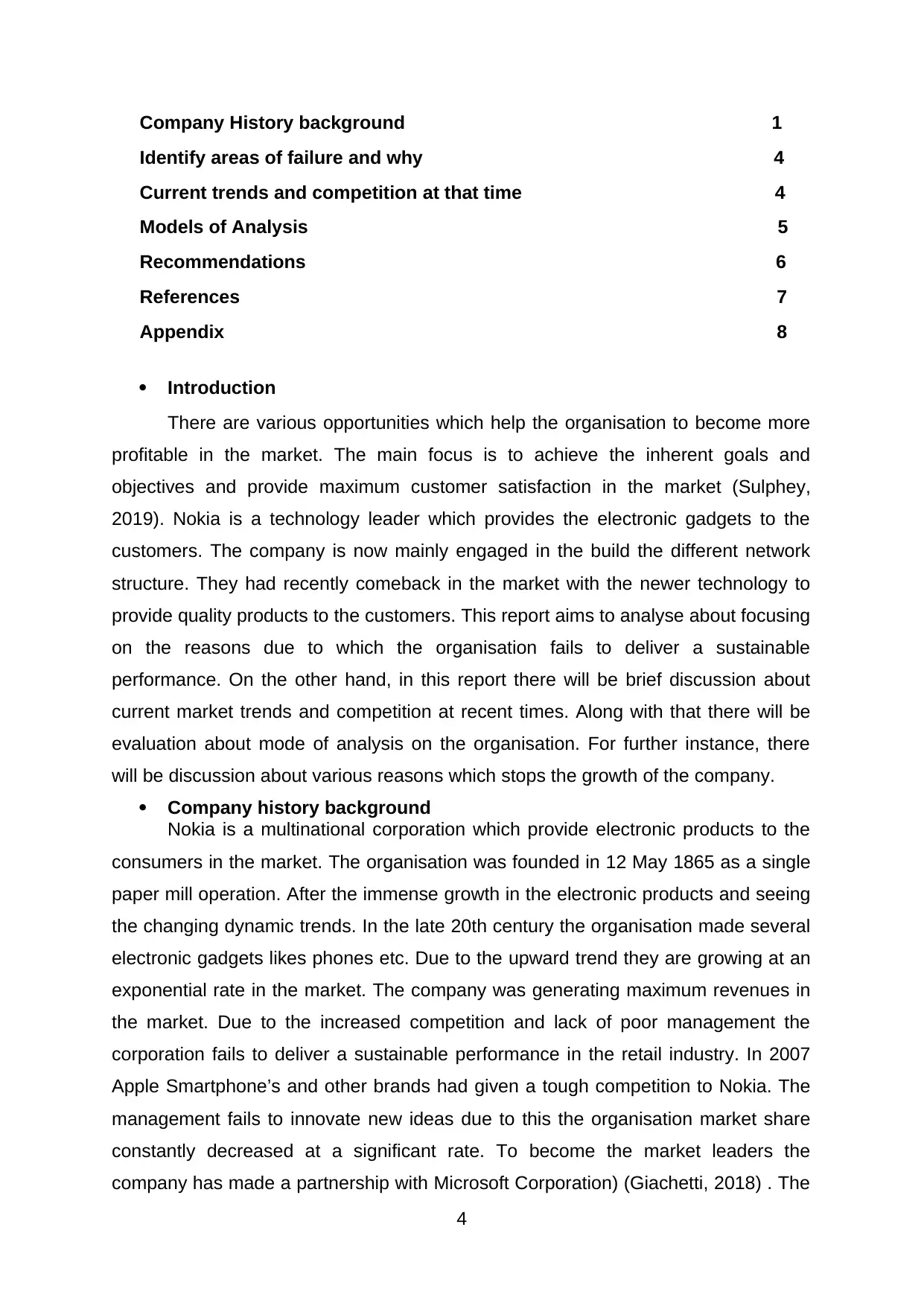
Company History background 1
Identify areas of failure and why 4
Current trends and competition at that time 4
Models of Analysis 5
Recommendations 6
References 7
Appendix 8
Introduction
There are various opportunities which help the organisation to become more
profitable in the market. The main focus is to achieve the inherent goals and
objectives and provide maximum customer satisfaction in the market (Sulphey,
2019). Nokia is a technology leader which provides the electronic gadgets to the
customers. The company is now mainly engaged in the build the different network
structure. They had recently comeback in the market with the newer technology to
provide quality products to the customers. This report aims to analyse about focusing
on the reasons due to which the organisation fails to deliver a sustainable
performance. On the other hand, in this report there will be brief discussion about
current market trends and competition at recent times. Along with that there will be
evaluation about mode of analysis on the organisation. For further instance, there
will be discussion about various reasons which stops the growth of the company.
Company history background
Nokia is a multinational corporation which provide electronic products to the
consumers in the market. The organisation was founded in 12 May 1865 as a single
paper mill operation. After the immense growth in the electronic products and seeing
the changing dynamic trends. In the late 20th century the organisation made several
electronic gadgets likes phones etc. Due to the upward trend they are growing at an
exponential rate in the market. The company was generating maximum revenues in
the market. Due to the increased competition and lack of poor management the
corporation fails to deliver a sustainable performance in the retail industry. In 2007
Apple Smartphone’s and other brands had given a tough competition to Nokia. The
management fails to innovate new ideas due to this the organisation market share
constantly decreased at a significant rate. To become the market leaders the
company has made a partnership with Microsoft Corporation) (Giachetti, 2018) . The
4
Identify areas of failure and why 4
Current trends and competition at that time 4
Models of Analysis 5
Recommendations 6
References 7
Appendix 8
Introduction
There are various opportunities which help the organisation to become more
profitable in the market. The main focus is to achieve the inherent goals and
objectives and provide maximum customer satisfaction in the market (Sulphey,
2019). Nokia is a technology leader which provides the electronic gadgets to the
customers. The company is now mainly engaged in the build the different network
structure. They had recently comeback in the market with the newer technology to
provide quality products to the customers. This report aims to analyse about focusing
on the reasons due to which the organisation fails to deliver a sustainable
performance. On the other hand, in this report there will be brief discussion about
current market trends and competition at recent times. Along with that there will be
evaluation about mode of analysis on the organisation. For further instance, there
will be discussion about various reasons which stops the growth of the company.
Company history background
Nokia is a multinational corporation which provide electronic products to the
consumers in the market. The organisation was founded in 12 May 1865 as a single
paper mill operation. After the immense growth in the electronic products and seeing
the changing dynamic trends. In the late 20th century the organisation made several
electronic gadgets likes phones etc. Due to the upward trend they are growing at an
exponential rate in the market. The company was generating maximum revenues in
the market. Due to the increased competition and lack of poor management the
corporation fails to deliver a sustainable performance in the retail industry. In 2007
Apple Smartphone’s and other brands had given a tough competition to Nokia. The
management fails to innovate new ideas due to this the organisation market share
constantly decreased at a significant rate. To become the market leaders the
company has made a partnership with Microsoft Corporation) (Giachetti, 2018) . The
4
Secure Best Marks with AI Grader
Need help grading? Try our AI Grader for instant feedback on your assignments.

main vision of the joint venture is to revolutionaries the market with the windows
operating system based products. Due to these joint operations they were seeing a
constant growth in the market. They had sold over one million windows phone to the
customers. They were also attaining maximum customer satisfaction with the
services and the products. But after sometimes the market evolves and brands like
Samsung and apple has emerged in the market. Nokia Corporation needs to
dominate the industry with the new superior products. The company fails to become
the market giants due to the poor management. They did not implement new ideas
and approaches with the changing market trends. In 2013 Microsoft Corporation has
acquired the company to become profitable in the market. They also fail to cop up
with the evolving trends. Afterwards, they also dismissed their operations from the
industry. The organisation again comes back in 2016 under the banner of HMD a
new company in Finland. Now, they have launched their smart phones with the new
android based so. The competition in the industry was so high that nokia fails to
deliver the performance and crushed again with the market giants. For example
brands like Samsung; Apple has acquired a significant market share.
Identify areas of failure and why
There are various major reasons which stop the growth of Nokia in the market.
The organisation fails to deliver a sustainable performance because of lack of
innovation and different critical factors are described below:
Poor management – Nokia poor management fails to understand the changing
market trends. Through this the organisation lacks in several factors. They need
to make the smart phones on the android operating system. The management
needs to agile and structured in every manner. The decision must be taken by
the studying the market effectively at various levels.
Lack of capital – This was the main issue which initiate different problems for
the organisation. The organisation had partnered with different investors and
stakeholders to generate capital. The main investor in the company was
Microsoft Corporation (Irfan, 2020). They had significantly invested a huge sum of
money in Nokia. There was no major impact in the market because of this joint
operation. They had significantly faced huge loss in the retail industry.
5
operating system based products. Due to these joint operations they were seeing a
constant growth in the market. They had sold over one million windows phone to the
customers. They were also attaining maximum customer satisfaction with the
services and the products. But after sometimes the market evolves and brands like
Samsung and apple has emerged in the market. Nokia Corporation needs to
dominate the industry with the new superior products. The company fails to become
the market giants due to the poor management. They did not implement new ideas
and approaches with the changing market trends. In 2013 Microsoft Corporation has
acquired the company to become profitable in the market. They also fail to cop up
with the evolving trends. Afterwards, they also dismissed their operations from the
industry. The organisation again comes back in 2016 under the banner of HMD a
new company in Finland. Now, they have launched their smart phones with the new
android based so. The competition in the industry was so high that nokia fails to
deliver the performance and crushed again with the market giants. For example
brands like Samsung; Apple has acquired a significant market share.
Identify areas of failure and why
There are various major reasons which stop the growth of Nokia in the market.
The organisation fails to deliver a sustainable performance because of lack of
innovation and different critical factors are described below:
Poor management – Nokia poor management fails to understand the changing
market trends. Through this the organisation lacks in several factors. They need
to make the smart phones on the android operating system. The management
needs to agile and structured in every manner. The decision must be taken by
the studying the market effectively at various levels.
Lack of capital – This was the main issue which initiate different problems for
the organisation. The organisation had partnered with different investors and
stakeholders to generate capital. The main investor in the company was
Microsoft Corporation (Irfan, 2020). They had significantly invested a huge sum of
money in Nokia. There was no major impact in the market because of this joint
operation. They had significantly faced huge loss in the retail industry.
5

Overexpansion – With the changing market the organisation has abruptly
increasing their operation. They were expanding the company in different
regions. After sometime Nokia faced backlash due to their inappropriate decision.
Change of the customer’s behaviour – Due to the changing customer
behaviour the organisation fails to become profitable in various situations.
Customer preferences are always evolving and the Nokia fails to understand the
market scenario.
Lack of innovation – The implementation of right strategies and approaches is
necessary to understand the market constraints in a systematic manner. The
company could innovate new ideas to achieve great outcomes in the future. They
could choose the right operating system which is android to become the market
leader.
Very slow or late entry into online shopping – The organisation fails to use the
right approach of online marketing. This could help them to attract new customers
in the market.
Lack of flexibility in terms of the market trends and changes – With the
evolving market the company needs to focus on improving their services and
make them superior. This will help them to gain a competitive edge over different
competitors in the market. Nokia growth stops because of their inflexibility and
the changing market conditions.
Ignoring the competitors – The organisation needs to closely monitor the
competitors in terms of doing their operations and products. Nokia does not see
the competition and brands like Samsung and Apple has shifted their technology
according to the customer needs.
Economic reasons – There were various economic reasons which make the
organisation to occur huge losses in the market. The main cause for the fall of
Nokia is industry diversification. Economic development could help the
organisation to grow at an efficient rate. In case of Nokia this was major factor
which make the organisation collapse in the market.
The range of products is not attractive to the customers any more –
Innovative products and services help the organisation to attract different
6
increasing their operation. They were expanding the company in different
regions. After sometime Nokia faced backlash due to their inappropriate decision.
Change of the customer’s behaviour – Due to the changing customer
behaviour the organisation fails to become profitable in various situations.
Customer preferences are always evolving and the Nokia fails to understand the
market scenario.
Lack of innovation – The implementation of right strategies and approaches is
necessary to understand the market constraints in a systematic manner. The
company could innovate new ideas to achieve great outcomes in the future. They
could choose the right operating system which is android to become the market
leader.
Very slow or late entry into online shopping – The organisation fails to use the
right approach of online marketing. This could help them to attract new customers
in the market.
Lack of flexibility in terms of the market trends and changes – With the
evolving market the company needs to focus on improving their services and
make them superior. This will help them to gain a competitive edge over different
competitors in the market. Nokia growth stops because of their inflexibility and
the changing market conditions.
Ignoring the competitors – The organisation needs to closely monitor the
competitors in terms of doing their operations and products. Nokia does not see
the competition and brands like Samsung and Apple has shifted their technology
according to the customer needs.
Economic reasons – There were various economic reasons which make the
organisation to occur huge losses in the market. The main cause for the fall of
Nokia is industry diversification. Economic development could help the
organisation to grow at an efficient rate. In case of Nokia this was major factor
which make the organisation collapse in the market.
The range of products is not attractive to the customers any more –
Innovative products and services help the organisation to attract different
6
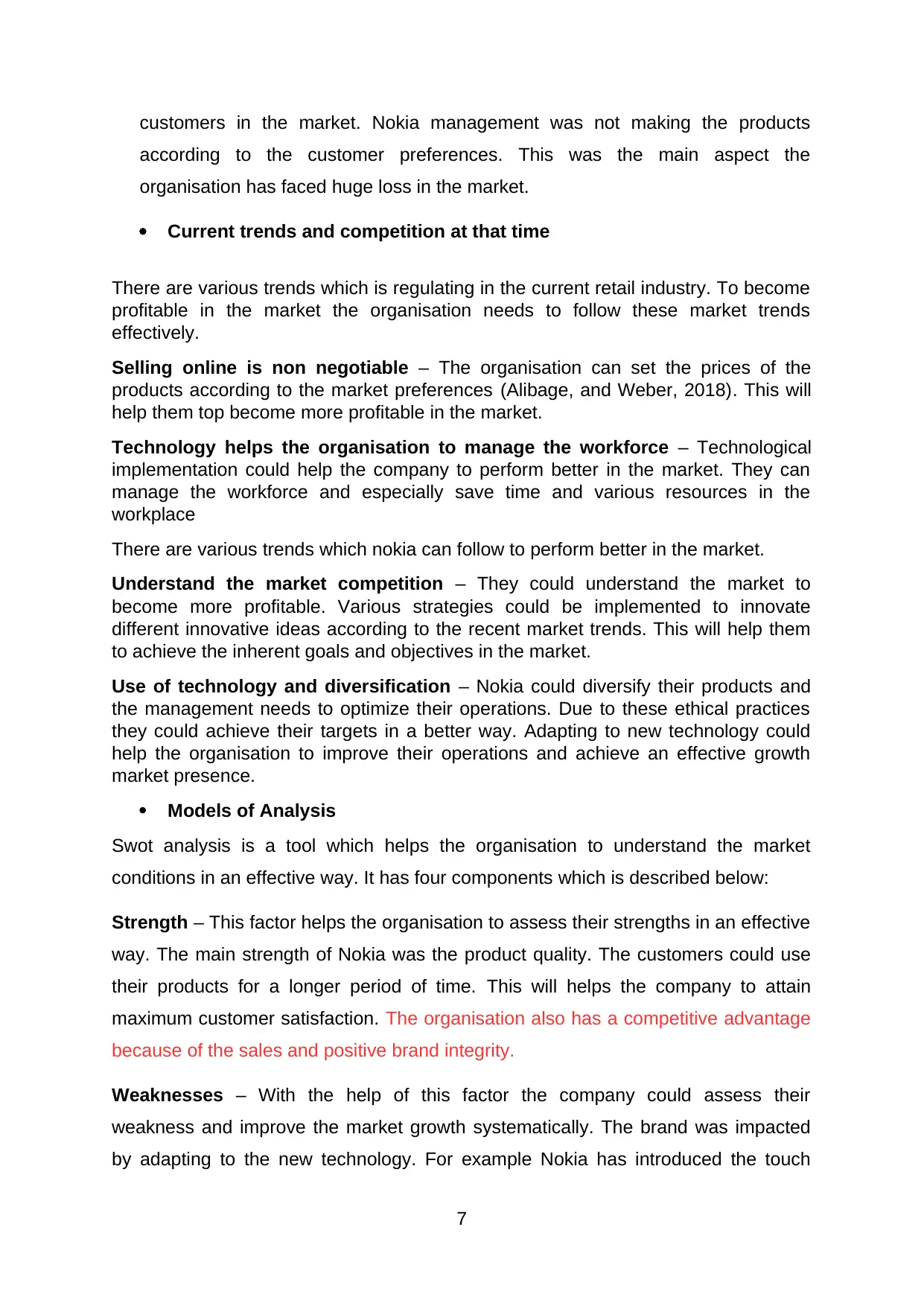
customers in the market. Nokia management was not making the products
according to the customer preferences. This was the main aspect the
organisation has faced huge loss in the market.
Current trends and competition at that time
There are various trends which is regulating in the current retail industry. To become
profitable in the market the organisation needs to follow these market trends
effectively.
Selling online is non negotiable – The organisation can set the prices of the
products according to the market preferences (Alibage, and Weber, 2018). This will
help them top become more profitable in the market.
Technology helps the organisation to manage the workforce – Technological
implementation could help the company to perform better in the market. They can
manage the workforce and especially save time and various resources in the
workplace
There are various trends which nokia can follow to perform better in the market.
Understand the market competition – They could understand the market to
become more profitable. Various strategies could be implemented to innovate
different innovative ideas according to the recent market trends. This will help them
to achieve the inherent goals and objectives in the market.
Use of technology and diversification – Nokia could diversify their products and
the management needs to optimize their operations. Due to these ethical practices
they could achieve their targets in a better way. Adapting to new technology could
help the organisation to improve their operations and achieve an effective growth
market presence.
Models of Analysis
Swot analysis is a tool which helps the organisation to understand the market
conditions in an effective way. It has four components which is described below:
Strength – This factor helps the organisation to assess their strengths in an effective
way. The main strength of Nokia was the product quality. The customers could use
their products for a longer period of time. This will helps the company to attain
maximum customer satisfaction. The organisation also has a competitive advantage
because of the sales and positive brand integrity.
Weaknesses – With the help of this factor the company could assess their
weakness and improve the market growth systematically. The brand was impacted
by adapting to the new technology. For example Nokia has introduced the touch
7
according to the customer preferences. This was the main aspect the
organisation has faced huge loss in the market.
Current trends and competition at that time
There are various trends which is regulating in the current retail industry. To become
profitable in the market the organisation needs to follow these market trends
effectively.
Selling online is non negotiable – The organisation can set the prices of the
products according to the market preferences (Alibage, and Weber, 2018). This will
help them top become more profitable in the market.
Technology helps the organisation to manage the workforce – Technological
implementation could help the company to perform better in the market. They can
manage the workforce and especially save time and various resources in the
workplace
There are various trends which nokia can follow to perform better in the market.
Understand the market competition – They could understand the market to
become more profitable. Various strategies could be implemented to innovate
different innovative ideas according to the recent market trends. This will help them
to achieve the inherent goals and objectives in the market.
Use of technology and diversification – Nokia could diversify their products and
the management needs to optimize their operations. Due to these ethical practices
they could achieve their targets in a better way. Adapting to new technology could
help the organisation to improve their operations and achieve an effective growth
market presence.
Models of Analysis
Swot analysis is a tool which helps the organisation to understand the market
conditions in an effective way. It has four components which is described below:
Strength – This factor helps the organisation to assess their strengths in an effective
way. The main strength of Nokia was the product quality. The customers could use
their products for a longer period of time. This will helps the company to attain
maximum customer satisfaction. The organisation also has a competitive advantage
because of the sales and positive brand integrity.
Weaknesses – With the help of this factor the company could assess their
weakness and improve the market growth systematically. The brand was impacted
by adapting to the new technology. For example Nokia has introduced the touch
7
Paraphrase This Document
Need a fresh take? Get an instant paraphrase of this document with our AI Paraphraser
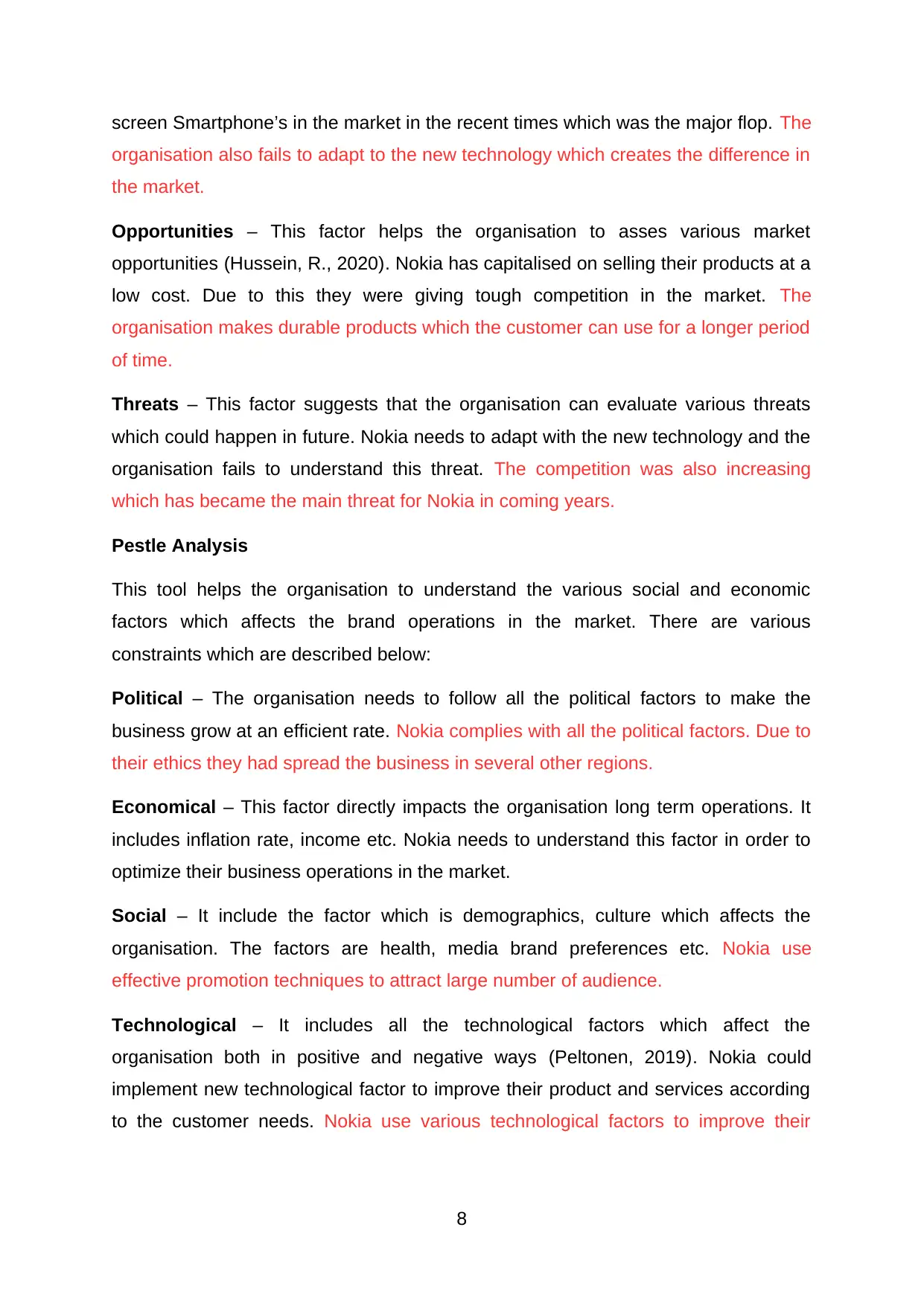
screen Smartphone’s in the market in the recent times which was the major flop. The
organisation also fails to adapt to the new technology which creates the difference in
the market.
Opportunities – This factor helps the organisation to asses various market
opportunities (Hussein, R., 2020). Nokia has capitalised on selling their products at a
low cost. Due to this they were giving tough competition in the market. The
organisation makes durable products which the customer can use for a longer period
of time.
Threats – This factor suggests that the organisation can evaluate various threats
which could happen in future. Nokia needs to adapt with the new technology and the
organisation fails to understand this threat. The competition was also increasing
which has became the main threat for Nokia in coming years.
Pestle Analysis
This tool helps the organisation to understand the various social and economic
factors which affects the brand operations in the market. There are various
constraints which are described below:
Political – The organisation needs to follow all the political factors to make the
business grow at an efficient rate. Nokia complies with all the political factors. Due to
their ethics they had spread the business in several other regions.
Economical – This factor directly impacts the organisation long term operations. It
includes inflation rate, income etc. Nokia needs to understand this factor in order to
optimize their business operations in the market.
Social – It include the factor which is demographics, culture which affects the
organisation. The factors are health, media brand preferences etc. Nokia use
effective promotion techniques to attract large number of audience.
Technological – It includes all the technological factors which affect the
organisation both in positive and negative ways (Peltonen, 2019). Nokia could
implement new technological factor to improve their product and services according
to the customer needs. Nokia use various technological factors to improve their
8
organisation also fails to adapt to the new technology which creates the difference in
the market.
Opportunities – This factor helps the organisation to asses various market
opportunities (Hussein, R., 2020). Nokia has capitalised on selling their products at a
low cost. Due to this they were giving tough competition in the market. The
organisation makes durable products which the customer can use for a longer period
of time.
Threats – This factor suggests that the organisation can evaluate various threats
which could happen in future. Nokia needs to adapt with the new technology and the
organisation fails to understand this threat. The competition was also increasing
which has became the main threat for Nokia in coming years.
Pestle Analysis
This tool helps the organisation to understand the various social and economic
factors which affects the brand operations in the market. There are various
constraints which are described below:
Political – The organisation needs to follow all the political factors to make the
business grow at an efficient rate. Nokia complies with all the political factors. Due to
their ethics they had spread the business in several other regions.
Economical – This factor directly impacts the organisation long term operations. It
includes inflation rate, income etc. Nokia needs to understand this factor in order to
optimize their business operations in the market.
Social – It include the factor which is demographics, culture which affects the
organisation. The factors are health, media brand preferences etc. Nokia use
effective promotion techniques to attract large number of audience.
Technological – It includes all the technological factors which affect the
organisation both in positive and negative ways (Peltonen, 2019). Nokia could
implement new technological factor to improve their product and services according
to the customer needs. Nokia use various technological factors to improve their
8
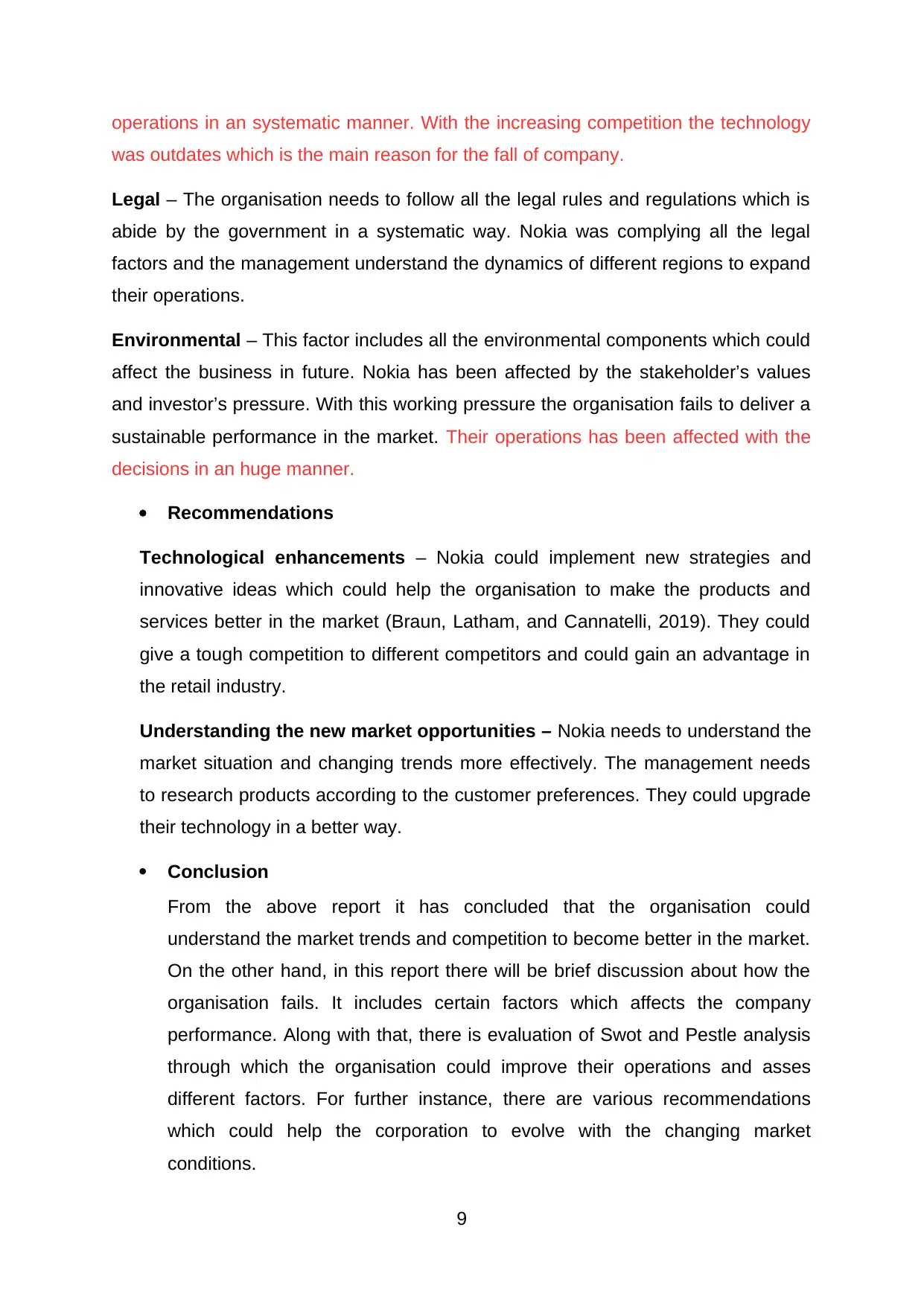
operations in an systematic manner. With the increasing competition the technology
was outdates which is the main reason for the fall of company.
Legal – The organisation needs to follow all the legal rules and regulations which is
abide by the government in a systematic way. Nokia was complying all the legal
factors and the management understand the dynamics of different regions to expand
their operations.
Environmental – This factor includes all the environmental components which could
affect the business in future. Nokia has been affected by the stakeholder’s values
and investor’s pressure. With this working pressure the organisation fails to deliver a
sustainable performance in the market. Their operations has been affected with the
decisions in an huge manner.
Recommendations
Technological enhancements – Nokia could implement new strategies and
innovative ideas which could help the organisation to make the products and
services better in the market (Braun, Latham, and Cannatelli, 2019). They could
give a tough competition to different competitors and could gain an advantage in
the retail industry.
Understanding the new market opportunities – Nokia needs to understand the
market situation and changing trends more effectively. The management needs
to research products according to the customer preferences. They could upgrade
their technology in a better way.
Conclusion
From the above report it has concluded that the organisation could
understand the market trends and competition to become better in the market.
On the other hand, in this report there will be brief discussion about how the
organisation fails. It includes certain factors which affects the company
performance. Along with that, there is evaluation of Swot and Pestle analysis
through which the organisation could improve their operations and asses
different factors. For further instance, there are various recommendations
which could help the corporation to evolve with the changing market
conditions.
9
was outdates which is the main reason for the fall of company.
Legal – The organisation needs to follow all the legal rules and regulations which is
abide by the government in a systematic way. Nokia was complying all the legal
factors and the management understand the dynamics of different regions to expand
their operations.
Environmental – This factor includes all the environmental components which could
affect the business in future. Nokia has been affected by the stakeholder’s values
and investor’s pressure. With this working pressure the organisation fails to deliver a
sustainable performance in the market. Their operations has been affected with the
decisions in an huge manner.
Recommendations
Technological enhancements – Nokia could implement new strategies and
innovative ideas which could help the organisation to make the products and
services better in the market (Braun, Latham, and Cannatelli, 2019). They could
give a tough competition to different competitors and could gain an advantage in
the retail industry.
Understanding the new market opportunities – Nokia needs to understand the
market situation and changing trends more effectively. The management needs
to research products according to the customer preferences. They could upgrade
their technology in a better way.
Conclusion
From the above report it has concluded that the organisation could
understand the market trends and competition to become better in the market.
On the other hand, in this report there will be brief discussion about how the
organisation fails. It includes certain factors which affects the company
performance. Along with that, there is evaluation of Swot and Pestle analysis
through which the organisation could improve their operations and asses
different factors. For further instance, there are various recommendations
which could help the corporation to evolve with the changing market
conditions.
9
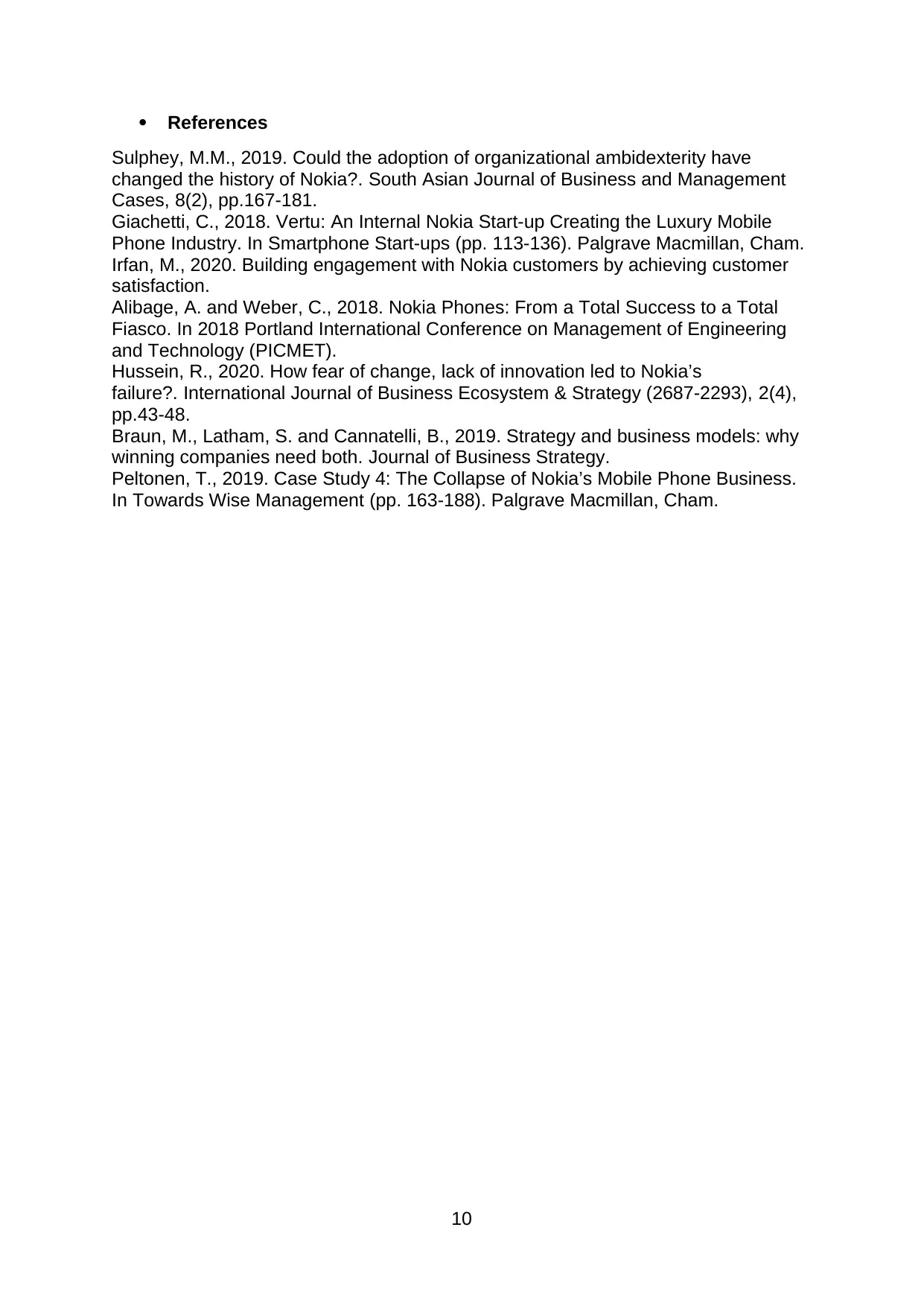
References
Sulphey, M.M., 2019. Could the adoption of organizational ambidexterity have
changed the history of Nokia?. South Asian Journal of Business and Management
Cases, 8(2), pp.167-181.
Giachetti, C., 2018. Vertu: An Internal Nokia Start-up Creating the Luxury Mobile
Phone Industry. In Smartphone Start-ups (pp. 113-136). Palgrave Macmillan, Cham.
Irfan, M., 2020. Building engagement with Nokia customers by achieving customer
satisfaction.
Alibage, A. and Weber, C., 2018. Nokia Phones: From a Total Success to a Total
Fiasco. In 2018 Portland International Conference on Management of Engineering
and Technology (PICMET).
Hussein, R., 2020. How fear of change, lack of innovation led to Nokia’s
failure?. International Journal of Business Ecosystem & Strategy (2687-2293), 2(4),
pp.43-48.
Braun, M., Latham, S. and Cannatelli, B., 2019. Strategy and business models: why
winning companies need both. Journal of Business Strategy.
Peltonen, T., 2019. Case Study 4: The Collapse of Nokia’s Mobile Phone Business.
In Towards Wise Management (pp. 163-188). Palgrave Macmillan, Cham.
10
Sulphey, M.M., 2019. Could the adoption of organizational ambidexterity have
changed the history of Nokia?. South Asian Journal of Business and Management
Cases, 8(2), pp.167-181.
Giachetti, C., 2018. Vertu: An Internal Nokia Start-up Creating the Luxury Mobile
Phone Industry. In Smartphone Start-ups (pp. 113-136). Palgrave Macmillan, Cham.
Irfan, M., 2020. Building engagement with Nokia customers by achieving customer
satisfaction.
Alibage, A. and Weber, C., 2018. Nokia Phones: From a Total Success to a Total
Fiasco. In 2018 Portland International Conference on Management of Engineering
and Technology (PICMET).
Hussein, R., 2020. How fear of change, lack of innovation led to Nokia’s
failure?. International Journal of Business Ecosystem & Strategy (2687-2293), 2(4),
pp.43-48.
Braun, M., Latham, S. and Cannatelli, B., 2019. Strategy and business models: why
winning companies need both. Journal of Business Strategy.
Peltonen, T., 2019. Case Study 4: The Collapse of Nokia’s Mobile Phone Business.
In Towards Wise Management (pp. 163-188). Palgrave Macmillan, Cham.
10
1 out of 10
Related Documents
Your All-in-One AI-Powered Toolkit for Academic Success.
+13062052269
info@desklib.com
Available 24*7 on WhatsApp / Email
![[object Object]](/_next/static/media/star-bottom.7253800d.svg)
Unlock your academic potential
© 2024 | Zucol Services PVT LTD | All rights reserved.




